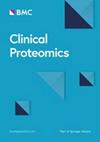小切口皮瓣摘除术(SMILE)和飞秒激光角膜切割术(FS-LASIK)术后泪膜蛋白图谱早期变化的比较
IF 3.3
3区 医学
Q2 BIOCHEMICAL RESEARCH METHODS
引用次数: 0
摘要
小切口皮瓣摘除术(SMILE)和飞秒激光辅助原位角膜磨镶术(LASIK)是目前广泛使用的矫治近视的手术方法,其疗效、可预测性和安全性都不相上下。我们研究并比较了 SMILE 和 FS-LASIK 手术后泪液蛋白的早期变化,以发现角膜初期愈合过程中可能存在的差异。我们使用 Visumax 飞秒激光为 26 只眼睛进行了 SMILE 手术。在30只眼睛的FS-LASIK手术中,使用Ziemer FEMTO LDV Z6飞秒激光制作角膜瓣,并使用Wavelight EX500准分子激光消融基质。使用玻璃微毛细管收集术前、术后 1.5 小时和 1 个月的泪液样本。泪液蛋白质的鉴定和定量是通过所有理论片段离子谱质谱(SWATH-MS)的顺序窗口采集进行的。与术前蛋白水平相比,我们发现SMILE术后89种蛋白和FS-LASIK术后123种蛋白在术后1.5小时立即出现了差异。在这些表达不同的蛋白质中,有 48 种蛋白质在两种手术类型中都有。但是,SMILE 和 FS-LASIK 在数量上存在差异。上调的蛋白质主要与炎症反应和与免疫系统有关的细胞迁移有关。手术一个月后,两种手术方法的蛋白质表达水平都恢复到了基线水平。我们的研究表明,SMILE 和 FS-LASIK 手术后蛋白质谱的即时变化以及不同方法之间的差异与炎症过程有关,蛋白质水平在一个月内迅速恢复到基线水平。不同方法之间蛋白质含量的差异可能与诱导的上皮伤口大小不同有关。本文章由计算机程序翻译,如有差异,请以英文原文为准。
Comparison of early changes in tear film protein profiles after small incision lenticule extraction (SMILE) and femtosecond LASIK (FS-LASIK) surgery
Small incision lenticule extraction (SMILE) and femtosecond laser-assisted in situ keratomileusis (LASIK) are widely used surgical methods to correct myopia with comparable efficacy, predictability, and safety. We examined and compared the early changes of tear protein profiles after SMILE and FS-LASIK surgery in order to find possible differences in the initial corneal healing process. SMILE operations for 26 eyes were made with Visumax femtosecond laser. In FS-LASIK surgery for 30 eyes, the flaps were made with Ziemer FEMTO LDV Z6 femtosecond laser and stromal ablation with Wavelight EX500 excimer laser. Tear samples were collected preoperatively, and 1.5 h and 1 month postoperatively using glass microcapillary tubes. Tear protein identification and quantification were performed with sequential window acquisition of all theoretical fragment ion spectra mass spectrometry (SWATH-MS). Immediately (1.5 h) after we found differences in 89 proteins after SMILE and in 123 after FS-LASIK operation compared to preoperative protein levels. Of these differentially expressed proteins, 48 proteins were common for both surgery types. There were, however, quantitative differences between SMILE and FS-LASIK. Upregulated proteins were mostly connected to inflammatory response and migration of the cells connected to immune system. One month after the operation protein expressions levels were returned to baseline levels with both surgical methods. Our study showed that immediate changes in protein profiles after SMILE and FS-LASIK surgeries and differences between the methods are connected to inflammatory process, and the protein levels quickly return to the baseline within 1 month. The differences in protein profiles between the methods are probably associated with the different size of the epithelial wound induced.
求助全文
通过发布文献求助,成功后即可免费获取论文全文。
去求助
来源期刊

Clinical proteomics
BIOCHEMICAL RESEARCH METHODS-
CiteScore
5.80
自引率
2.60%
发文量
37
审稿时长
17 weeks
期刊介绍:
Clinical Proteomics encompasses all aspects of translational proteomics. Special emphasis will be placed on the application of proteomic technology to all aspects of clinical research and molecular medicine. The journal is committed to rapid scientific review and timely publication of submitted manuscripts.
 求助内容:
求助内容: 应助结果提醒方式:
应助结果提醒方式:


